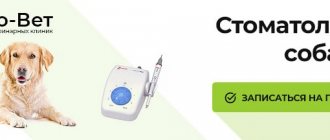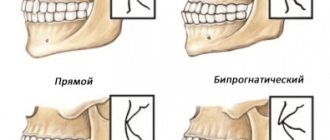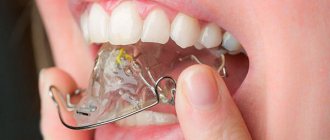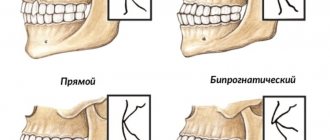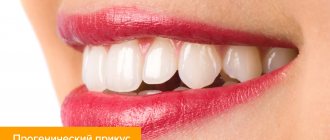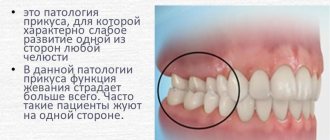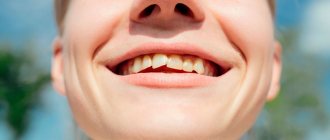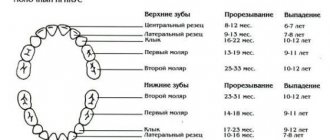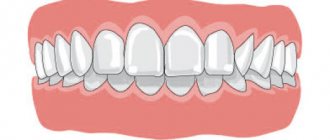Main types of bite
The jaws of dogs of different breeds may be positioned differently in relation to each other. The types of bites in dogs are as follows:
- scissor-shaped (normal);
- pincer-shaped (straight);
- undershot;
- snack (bulldog-shaped).
The bite of such pets depends primarily on the structure of their jaws. The latter can have different lengths and development.
Sometimes a dog's jaws can be distorted. Also, the position of the teeth has a great influence on the bite. Sometimes it happens that the dog’s jaws themselves are fine, but the teeth grow incorrectly.
Why is the bite deformed?
There are several reasons for malocclusion. This phenomenon may be congenital, or it may become acquired over a period of time. Main reasons:
- Most often it is a genetic problem, which is why purebred dogs suffer, especially small breeds (Papillons, lapdogs, corgis). It is worth noting that puppies are carefully culled and are never used to breed dogs with jaw defects.
- Injuries can cause dental problems. Especially those that occur at a young age.
- Defects can develop due to a lack of nutrients and minerals. At the same time, the lack of such elements in a pregnant bitch will also have a negative impact on the puppy.
- Violent games, when there is a lot of stress on the jaw, can also provoke a problem in the future. As a result, a dog may grow up with teeth forward.
Attention! Malocclusion in pets can also be caused by poor nutrition and lack of nutrients, resulting in dental problems.
Incorrect positioning of teeth causes many problems for your pet.
Scissor bite
Representatives of the canid genus are known to belong to the group of predators. In the wild, such animals hunt other animals in order to feed themselves. Therefore, the structure of the jaws of canids, including dogs, is designed primarily to grab and hold prey. In this regard, the most physiological is the scissor bite.
This jaw structure is considered normal for most dog breeds. Animals with such a bite have much less wear and pain in their teeth. This structure is considered the norm, for example, for Caucasian and German shepherds, terriers, pinschers, and Dobermans. That is, the correct bite in dogs of most breeds is a scissor bite.
In this case, dogs’ jaws are developed harmoniously. The front surface of the lower incisors is tightly adjacent to the back surface of the upper ones. The canines of dogs with this type of bite meet in a “lock.” In this case, the lower incisors rest against the base of the upper ones. Photos of the bite in dogs of this variety can be seen above.
How to distinguish the correct bite
The correct bite is called a scissor bite. When the dog closes its jaws, the teeth are brought together into a lock, the incisors from below touch the back of the incisors from above.
Which bite requires correction:
- straight - the incisors on both sides are located above each other, which prevents the chewing teeth from behind and the fangs from closing. As a result, the entire load when chewing food is taken on by the incisors, which wear out faster. Teeth that chew food decay faster;
- overshot - the upper incisors are behind the lower ones. Such a bite can only be considered correct in fighting dogs;
- undershot - the incisors on top, on the contrary, protrude above the lower ones. This is the most dangerous pathology for a dog’s health, although many dog owners consider it a cute feature of their pet;
- open - the incisors on the jaw do not touch at all;
- cross - the lower incisors extend beyond these teeth on the upper jaw;
- curve - with different degrees of development of the jaws, which makes the muzzle look asymmetrical.
Veterinarians know cases where baby teeth do not fall out, but grow together with the molars, and two “sets” grow in the mouth at once. This is also considered an anomaly, like non-eruption of molars.
Pincer bite
This jaw position is considered unacceptable for most dog breeds. However, a pincer bite is still considered a not too serious defect. In this case, the dog’s lower and upper incisors are located on the same line and rest against each other. Because of this, they wear down very quickly. A direct bite in dogs usually does not have a negative effect on canines and molars.
Pincer-like closure of the incisors in dogs can be either congenital or acquired. Such a defect can develop, for example, due to the puppy playing tug too actively. Excessive loads of this kind, of course, are unlikely to have a negative impact on the jaw. However, a puppy's lower incisors may begin to move forward when pulled.
Teeth and bite
Bite is the relative position of the teeth of the upper and lower jaw. The bite is one of the most important indicators of a dog’s exterior. The correct bite for each breed is determined by the standard.
Depending on the form of closure of the teeth, it is customary to distinguish several types of bite in dogs: scissor bite, underbite, pincer bite, and overshot bite.
Scissor bite
Most breeds have a scissor bite (normal bite), where the upper row of incisors covers the lower incisors so that the lower incisors touch the inner surface of the upper incisors. It provides the least wear on teeth and a strong grip.
Scissor bite in lock
This bite forms a strong and secure “lock” when the lower canines are located directly between the outer incisors and the upper canines. There should be no contact between the canines and any other teeth. The edges of the upper and lower premolars should be mutually spaced like the teeth of a gear. A scissor bite is also characteristic of wild canids.
Normally, the incisors close vertically and extend deeply beyond each other. Sometimes the closure of the incisors does not occur vertically, but at a greater or lesser inclination (alveolar inclination).
A scissor bite does not prevent teeth from being misaligned. Breeders must understand and pay attention to the fact that along with the scissor bite, the canines, premolars and molars must also be positioned correctly. It often happens that premolars or molars are in an overbite or underbite position, despite a scissor bite between the upper and lower incisors.
Anomalies of a scissor bite include situations in which the jaws close normally, but one or more teeth have an altered position in the dental arch. Such anomalies in a typical case are not due to genetic reasons. However, some syndromes are common in certain breeds (eg, mesial displacement of the maxillary canines (lances) in Shelties, Scotch Terriers, and Italian Greyhounds), which in some cases may indicate a genetic predisposition.
Anterior crossbite (rostral crossbite, frontal crossbite) is a scissor bite in which the canines and premolars occlude normally, but one or more lower incisors are positioned in front of the upper incisors. In adult dogs, rostral crossbite may be caused by retained primary teeth.
Posterior crossbite (caudal crossbite) is a bite in which one or more lower premolars overlap the upper premolars. This phenomenon is thought to be uncommon, but it is becoming very common in Doberman Pinschers and Collies.
Malocclusions can be caused by many reasons, for example, pressure on the lip/cheek/tongue (or lack of such pressure), as well as systemic or endocrine disorders. In most cases, such malocclusions are only cosmetic in nature and do not cause any harm to the animal, but sometimes they can lead to injury to soft tissues.
Malocclusion (malocclusion) indicates any improper closure of the teeth. Malocclusion can be dental or skeletal in origin, with skeletal anomalies usually leading to poor occlusion. Severe malocclusions are extremely rare in wild canids.
Risks: For retrievers and obedience dogs, any malocclusion can lead to discomfort or pain, loss of function and serious dental problems. This can also change the dog's perception of objects. For police dogs and Schutzhund dogs, any malocclusion interferes with their ability to close their teeth tightly. Without a firm grip, these dogs are much more susceptible to injury and are at greater risk of breaking teeth. Frisbee participants with an incorrect bite are at higher risk than dogs with a correct bite, especially when they catch the disc at top speed.
A pincer bite (level bite) is formed when the incisors of both jaws touch their cutting edges. This bite is acceptable according to some standards, especially in animals over 5 years of age. Since the incisors bear a significant load, this leads to significant wear on the incisor surfaces; in some cases, only “stumps” may remain of the teeth, which can lead to periodontal disease. This deviation has practically no effect on canines and molars. About 30% of adult wolves have a straight bite.
Underbite
Underbite (shark mouth, brachygnathism, prognathism) is a bite in which the upper incisors are in front of the lower ones, creating a space between these two levels. This type of malocclusion can be caused by a “dental block,” where the puppy’s teeth become embedded in the soft tissue of the opposing jaw, preventing jaw growth. Undershot is listed as a fault in all breed standards because over time it can damage the gums or upper palate.
Underbite
It is believed that underbite is due to genetic reasons. An injury received at an early age with the formation of a bone callus or damage to the growth plate can also lead to the development of this disorder. However, in most cases the nature of the injury is unilateral. This disorder is common in Rhodesian Ridgebacks and Labradors. Underbite is often detected at the stage of primary teeth.
Another form of bite is also found in dogs - “compensated underbite”; experts in the rings often consider it a variant of the norm. It is characterized by some lightening and shortening of the lower jaw in combination with an alveolar inclination of the incisors and partially canines.
Snack
Overshot (progenia, bulldog, bulldog bite, bulldog jaw, bite, pike bite, underbite) - a bite in which the lower incisors are in front of the upper incisors. An undershot is a skeletal malocclusion, most often formed due to shortening of the facial bones of the skull.
Snack
This overbite is considered normal in short-headed (brachycephalic) breeds such as the Boxer, Bulldog, Brussels Griffon, Pekingese, Shih Tzu, French Bulldog, and Dogue de Bordeaux; it is allowed in the standards of the Bullmastiff, Affenpinscher, English Toy Spaniel, Japanese Chin, Pug, Boston Terrier, Lhasa Apso, Tibetan Spaniel and Tibetan Terrier. To create the specific appearance of the head and jaw that the authors of these original standards considered important, a snack was required. In all other breeds it is classified as a fault. Although legal in many breeds, it is a non-functional bite and cannot be found in the wild.
The dog shines its teeth
The snack can be without waste (dense), or with waste. If the mandibular incisors are positioned immediately in front of the maxillary incisors, it is called a reverse scissor bite (tight overbite). When the distance between the incisors is greater, it is called an overshot bite. Sometimes the deviation is so significant that the teeth of the lower arcade are visible even with the jaws closed (bulldog) - “the dog is shining its teeth.”
With this bite, in most cases there is no significant trauma to the soft tissues of the oral cavity; sometimes trauma to the gums of the lower jaw may occur with the incisors of the upper jaw.
Risks: Many veterinarians who work with service dogs believe that when overbiting, the neck is constantly held in an unnatural position with a reverse bend. Such compensations make jumping much more difficult. If the dog is asked to jump with something in its mouth (for example, fetching a fetch object while jumping over a barrier in obedience), the dog must further change the bend of its neck to hold the object. Overbite dogs that participate in agility and obedience increase stress on the lower back when they hold their head and neck up. Hunting dogs or retrievers with a bite increase stress on the neck and lower back when carrying a heavy bird or dumbbell; they also have a harder time picking up such items. These dogs may develop back pain, and if they have straight shoulders, the problem may get worse. Snacking costs dogs their natural tool for scratching, the ability to pull objects out of their fur or paws.
An open bite is when the teeth in front do not meet. Often puppies have a tendency to push their tongue into this gap, which can put pressure on the front teeth and worsen the bite. An open bite is also observed in those dogs in which, when the jaws close, there is a significant space between the upper and lower premolars, as is often observed in collies and Dobermans.
Jaw misalignment is best described as one of the four quadrants of the jaw being out of proportion to the other three quadrants. The jaws don't actually meet. Of all the malocclusions, a misaligned jaw is undoubtedly one of the worst. One side of the jaw is longer than the other, which can be seen as a deviation from the midline when the incisors of the upper and lower jaw meet.
Risks: Jaw misalignment is a defect in all dogs and is associated with a serious hereditary defect or trauma to the face that affects bone growth. Regardless of the cause, a misaligned jaw can lead to problems with gripping and chewing.
A common myth is that the bite is damaged. Overshot or undershot is a hereditary defect associated with underdevelopment of the upper or lower jaw, or with the non-linear development of the dental system, and is in no way connected with the incorrect actions of the owner. In some cases, a dog is genetically determined to have a normal bite, but for some time there is a violation of closure. In such cases, the degree and severity of the closure disorder is usually weak. These temporary occlusion disorders occur when the upper and lower jaws grow at different rates. On the contrary, a significant degree of malocclusion in primary teeth should be considered permanent.
In many cases, the primary tooth may be retained by the tooth or soft tissue of the opposing jaw, resulting in deviation of jaw development and subsequent passive negative malocclusion. this is called an “antagonistic dental lock.”
For working and sporting dogs, malocclusion can lead to discomfort or pain, inability to perform assigned tasks, and dental problems. A poor bite in protection dogs can weaken their grip and be at greater risk of breaking teeth. This is also important in sports such as frisbee, when catching a disc at high speed.
Underbite
This defect is considered more serious than a pincer bite. Underbite causes disqualification at shows of most dog breeds. The lower jaw in animals in this case is underdeveloped. Because of this, the dog has free space between the incisors. The lower canines are loosely adjacent to the edges of the upper jaw.
This type of defect can lead to the development of serious dental diseases in pets. The most affected dogs with this type of bite are the canines and molars. In this case, they are adjacent to each other too tightly. Also, dogs with this problem often develop tartar.
Why do dogs' teeth become loose and fall out?
All puppies are born without teeth.
After 3-6 weeks, your dog's baby teeth will begin to emerge. Changing teeth is a natural part of growing up and occurs from approximately 3.5 to 8 months. Baby teeth are so tiny that you may not even notice they are falling out. Many puppies swallow them while eating or they fall out while playing. Teeth swallowing is not harmful to your puppy, and minor bleeding is not something to worry about either.
In adult dogs, the main causes of tooth loss include:
● Genetic pathologies
● Inflammatory diseases of the oral cavity
● Injuries
Snack
This problem is most often encountered by owners of dogs with shortened jaws. For some breeds, such a bite is considered normal. For example, undertaking in bulldogs, bull terriers, and Pekingese is not considered a defect.
In this case, the dog's lower incisors protrude in front of the upper ones. The lower jaw of the animal protrudes forward. With such a defect, the dog’s canines and incisors may even be exposed. This type of bite is especially common in bulldogs. Probably many people have seen dogs of this breed with a far protruding lower jaw. This is why this type of bite is often called a bulldog bite.
What other defects are found?
In addition to those described above, dogs may experience other types of malocclusions. For example, a fairly common occurrence in such pets is misalignment of the jaws. In this case, a void may form on one edge between the dog’s incisors. Veterinarians call this defect asymmetry. Of course, this arrangement of the jaws can also cause the development of various kinds of diseases in a pet.
Sometimes, as already mentioned, a malocclusion in a dog can be associated with defects in the location of the teeth. A fairly common pathology in purebred dogs is retroposition. In this case, for example, the canines on the dog's lower jaw may be shifted to the center. This defect is quite common in Yorkshire terriers.
What is childhood underbite in a puppy?
Correct jaw closure is formed by 1.5 months, when babies undergo activation. It is necessary to assess the condition of newborns and ends with the issuance of metrics.
At this age, puppies may have childhood underbite. The defect is characterized by a slight deviation of the lower jaw relative to the upper jaw. Most often, it corrects itself when baby teeth are replaced with molars.
Malocclusion in a puppy at such an early age is not a pathology. In fact, the gap between the jaws is not due to underbite at all, but to small baby teeth. When replaced with radical ones, they increase in size, closing in the required ratio without additional interventions.
Causes of malocclusion
In ordinary yard dogs, jaw defects are relatively rare. Malocclusion in most cases is a genetic disease. And therefore, owners of purebred dogs most often face this problem. It was noted that in most cases such a defect occurs in small dogs.
Breeders, of course, always make sure that their wards only produce puppies that meet the breed standards. And therefore, when choosing manufacturers, the applicants’ teeth are always examined. The bite of dogs selected for breeding must fully comply with breed standards. Animals with incorrect jaw position are never allowed to be bred.
In addition to genetic failures, the reasons for the development of such a defect may be:
- lack of minerals in the diet of a pregnant bitch and puppies;
- jaw injuries at a young age;
- too active games with a lot of stress on the jaws.
Sometimes malocclusion in dogs also becomes a consequence of problematic replacement of baby teeth (too firmly seated or very large).
Causes of malocclusions
The most common cause of malocclusion, unfortunately, cannot be eliminated. This is a hereditary factor. The only way to prevent its spread to offspring is to deprive genetically inferior animals of permission to breed.
In addition, this pathology can also be acquired. It is most often caused by insufficient care of the puppy. There are several such factors:
- Repeated heavy loads on the teeth of a young animal during active games of tug are very unhelpful for him. You need to carefully control the force with which the puppy pulls the coveted toy.
- The consequences of trauma and damage to the jaws when chewing bones and hard objects often lead to malocclusion.
- Violation of the timing of the loss of milk teeth leads to the fact that the growing molars, bumping into the missing milk teeth, change their direction of growth.
- Lack of calcium, vitamin D, and an unbalanced diet lead to rickets and gradually deform the bite.
- Abnormally short labial frenulums cause the teeth to be compressed, causing the bite to become pathological.
How to prevent the development of defects: feeding
In order not to encounter the problem of malocclusion in the future, the owners of the puppy immediately after purchasing it need to choose the most suitable and balanced diet for it. Ready-made pet food should be purchased of the highest quality. At the same time, you also need to ensure that the composition of the “pads” corresponds to the age of the pet. Dogs kept on natural food must be given special vitamin and mineral supplements in their diet. In this case, you should choose a specific type of such premix in accordance with the recommendations of the veterinarian.
How long should you wear braces?
At the time of active formation of the dentition, the plates are changed approximately every six months. The duration of treatment is determined individually. Usually the defect is corrected in a year to a year and a half, further time is required to consolidate the result. Often plates are placed on braces after treatment to secure the result as a retainer. You shouldn't be afraid of this.
Caring for teeth straightening plates
In order for the equipment to work as expected, you need to perform simple operations. For this it is recommended:
- Clean the plate with a soft toothbrush;
- Use special cleaning gels (daily and weekly);
- Do not engage in active sports with the plate on;
- Store the equipment in a special container;
- Do not try to repair the plate yourself if you discover damage or deformation. You should consult your doctor;
- Treat the structure with a disinfectant solution. If the plate is removable, it is better to place it in the solution overnight;
- Remove the removable plates when eating;
- Before installation, rinse with warm boiled water;
- If the equipment design has a screw, it is recommended to lubricate it with vegetable oil so that it does not stagnate;
- Parents should ensure that the child does not remove the equipment at night;
- Teach your child how to tighten a screw in a plate;
- To avoid complications, periodically visit an orthodontist and follow his instructions;
- Carefully monitor oral hygiene during treatment (the presence of plates increases plaque in the mouth);
- If plaque or tartar is found on the plate, you should consult a doctor for cleaning.
The treatment is helped by a special massage that affects the gums and palate. By improving blood circulation, massage accelerates the healing and growth processes in the jaw area. This massage is performed while brushing your teeth.
Periodic inspections
To prevent the development of malocclusion in a pet, owners should also periodically check its oral cavity. In particular, this procedure often needs to be performed during the change of the puppy’s milk teeth. If the owner discovers that they are interfering with the growth of permanent ones, the pet should be immediately taken to the veterinarian. The specialist will remove the puppy’s baby tooth, and the permanent one will grow in the correct position.
For older puppies, the oral cavity is examined to identify abnormally growing teeth. Correcting a bite in young dogs is much easier than in adults. In order to achieve the correct position of the teeth, puppies usually simply wear a special rubber ring.
How to solve a problem
Acquired malocclusions can be corrected. This is not a task for one week or even a year, but the efforts will be generously rewarded. Upon completion of treatment, the dog will be able to take part in exhibitions and will be allowed to breed.
But even if the owner does not have the goal of pursuing a show career, it is necessary to treat his pet’s pathological bite. This is the key to his health and full life. It is better to do this when the puppy is not yet a year old.
Let's look at how to correct a dog's bite. This can be done in several ways, namely:
- removable devices;
- non-removable structures.
Removable devices
These include the so-called transparent removable aligners. They are placed over the teeth and should be worn at all times except when eating and brushing teeth. Their effect is constant and fairly strong pressure on the teeth in the desired direction. Every few months the design is replaced with a new one. It exerts stronger pressure, under the influence of which the teeth take the right direction. The orthodontic veterinarian must monitor the treatment process.
Removable braces can be used for puppies. They are shaped like a hard rubber ring. The principle of their action is the same, but they exert gentler pressure on the teeth.
Fixed structures
These are permanent braces. They are made of dense material and are firmly attached to the teeth using special dental glue. The force of their pressure is regulated using a special wire that connects the clasps that are put on the teeth. If necessary, the wire can be changed, thereby increasing or decreasing the pressure force.
Fixed structures have their contraindications. They cannot be installed if you have periodontal disease, stomatitis, or an allergic reaction to the braces material. Treatment is usually long-term.
Fixes
Unfortunately, in most cases, it is quite rare to achieve a normal bite in a dog with incorrect position of the jaws or teeth. But of course, its owners can try to help such a pet.
There are only two ways to correct a bite in dogs:
- surgical;
- orthodontic.
Veterinarians use the first technique to correct the position of animals’ jaws. The second technology is used for dog teeth.
Prevention
Malocclusion is not always a congenital genetic feature. In most cases, simple preventive measures will help avoid this defect. We will talk about these measures further.
First of all, you need to pay attention to the proper nutrition of your pet. It is important to ensure that his diet contains enough calcium, vitamin D3 and other important microelements. Dry food must be selected strictly according to the age category of the animal. If you feed your puppy natural food, take care of additional vitamin and mineral supplements.
Bring your dog to the veterinarian regularly. This issue should be given particular importance when baby teeth are replaced by molars. During this period, the bite is often disturbed due to captive baby teeth: therefore, if necessary, the latter are removed. Sometimes the dog's chewing of hard toys and objects can help the rapid loss of baby teeth.
If your puppy has started to develop an incorrect bite, a rubber ring installed by a veterinarian will help correct the situation at an early stage. It is only important not to let the situation take its course, and take measures to correct the problem as early as possible.
Attention : all preventive measures should be taken when the dog is still a puppy: the earlier, the better.
So, we have learned what a correct bite in dogs is, and how such a defect can be eliminated. As you can see, the incorrect position of the teeth has a negative impact not only on the dog’s appearance, but is also harmful to its health. Pay attention to the position of your pet’s teeth, and be sure to contact a competent veterinarian in a timely manner if there is a need to correct the bite.
Currently reading:
- Thyroid dysfunction in dogs (hypothyroidism)
- Seven Signs and Remedies for Getting Rid of Fleas in Dogs
- How to recognize signs of dog poisoning from rat poisons
- Ways to manage parvovirus infection in dogs
Using braces
Such orthodontic devices are used to correct bites in dogs quite often. The operating principle of this type of structure is extremely simple. Braces press the dog's teeth into the correct position. The animal usually does not experience any particular discomfort. Under the pressure of braces, the dog's teeth gradually begin to shift. In this case, the free space formed in the same place is filled with bone tissue.
In some cases, wearing braces for dogs may, of course, be contraindicated. Do not correct an animal’s bite in this way, for example, if they have problems such as:
- allergy;
- ulcerative stomatitis;
- gingivitis;
- formations in the oral cavity.
Dogs wearing braces must also have their teeth brushed. Therefore, pet owners who decide to correct their bite using such a design should begin to accustom them to such a procedure in advance.
Dentures for dogs
A pathological bite in a dog, as already mentioned, easily leads to various types of dental problems in the pet. It is often impossible to correct this defect. In this case, dogs' teeth wear down very quickly. And so that the animal does not have problems with the gastrointestinal tract, in this case it is possible to order prostheses for it.
The technology for performing a dental procedure is similar to the technique for installing crowns in humans. Such a procedure is, of course, expensive. But it also helps to maintain your pet’s health very effectively. Unlike people, dogs often have metal teeth inserted into them. After all, such crowns are cheaper than ceramic ones.
Currently, not all veterinary clinics provide dental installation services for dogs. But finding a specialist who has the skills to install crowns on animals in our time will not be difficult, including in Russia.
Dental injuries
Both adult dogs and puppies can injure their teeth. Usually, dislocations and fractures of teeth occur due to playing with sticks, bones, too dense toys, or horns. Access to all dangerous objects must be prohibited.
Features of tooth loss in dogs of large and small breeds
Teeth loss, as well as tooth loss, begins earlier in miniature breed dogs. However, there can be exceptions to any rule. Genetic factors, hygiene, and oral diseases can influence tooth loss.
Medium and large breeds
With good oral care, teeth in large and medium-sized dogs begin to fall out due to age-related changes around the age of 10 years. First, your pet will begin to lose the lower incisors due to increased stress on them and a weak root. The remaining teeth are held more firmly in the jaw, so the dog may lose them due to periodontitis. In a healthy oral cavity, teeth can wear down with age and can be preserved into old age with proper care.
